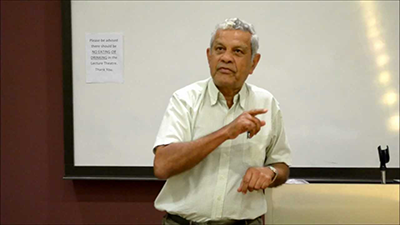(Trinidad Guardian) University of the West Indies history professor, Dr Brinsley Samaroo, great-grandson of indentured Indians, in a moving search for his roots in India, found his relatives in the village of Baraich in Uttar Pradesh and keeps a close connection with them.
A graduate of Delhi University and descended from the Somaroos from Bahraich in Northern India, Samaroo said he has been travelling frequently to India after his studies there to do research and bond with his relatives.
“I can go back at will to my village and I am treated well.” He said they actually had a piece of land that was left for his great-grandfather which they offered him. “They joked, do you want that or can we take it.”
Samaroo, a Presbyterian, said he is valued by his Hindu Indian relatives because he fills a void in their lives created when his great-grandparents left India.
He said to this day Indians in Baraich and different villages in Uttar Pradesh and Bihar, where the majority of Indian immigrants came from, yearn to know where brothers, uncles, other relatives went, if they were killed or suffered.
“It pleases me that I am able to go to their villages and fill that void, give them some kind of closure. I tell them about the villages the Indian created here and they are happy to know they did not come here and were killed.”
He said Baraich was a village when his great-grandparents left it but is now a thriving agricultural town cultivated with pomegranate, mango, pineapple, guava, rice, lentils and even sugar cane.
“It’s quite big now and it was with great difficulty I was able to find the particular region from where my great-grandparents came.”
Samaroo said he meets people in these villages looking just like Trinidadian Indians who eat the same kind of food prepared in exactly the same way.
“When you go to these villages you get food your mother used to make, sada roti, dhalpuri, talkari made with exactly the same ingredients. You see the Indian from whence you came still very much alive.”
He said India has started doing research into Indian indentureship and has actually begun to celebrate Indian Arrival Day and it is becoming quite popular there.
Samaroo, who did specific research on the humble jahaji bundle Indians brought here with them, spoke to the T&T Guardian on the eve of Indian Arrival Day on his Indian roots and how 143,939 Indians who arrived here between 1845 and 1917 not only changed the economic and social landscape of T&T but its physical space, as well.
He has been going to schools in different areas, like Penal/Debe, giving students lectures on the jahaji bundles brought to T&T by Indians, modest pieces of cloth tied to long sticks, which carried the seeds of new fruit trees and vegetables which were to later change the literal geography of the island.
Given swamplands by the colonial authorities after their indentureship was over, they also transformed wet, marshy areas, like Felicity, into thriving villages.
Samaroo said Indians who came poor, bedraggled and as semi-slaves have today transformed themselves and the geography of the Caribbean islands where they settled.
“In their jahaji bundle, which was like a very large three cornered handkerchief tied to the top of a large stick, they brought a remarkable range of seeds of fruit, vegetables and herbs we didn’t have in the Caribbean.

The Indians brought ganga (marijuana) to the Caribbean because it was not illegal and prohibited and used it very sparingly as a form of relaxation in the evening, he said.
Samaroo said Indians were given the worst lands after their indentureship, the swamplands of Caroni, Oropouche and Nariva.
“If you go and look at these swamplands now, you see remarkable transformation. Indians had thousands of years of experience in India in converting swamplands to profitable lands.
“In places like Felicity, Barrackpore, Plum Mitan, they changed the physical geography by draining and cultivating these areas and making them profitable.
“Indians created villages where there were no villages before out of swamp and jungle and gave them ancestral Indian names, like Chandanagore, which means place where the moon shines, Calcutta Settlement Number One and Two, Madras Settlement, Coromandel, Malabar, Barrackpore, Fyzabad and Eli Road.”
Samaroo will lecture on Indian indentureship at the Sangre Grande Civic Centre at 11 am today.
“When you go to these villages you get food your mother used to make, sada roti, dhalpuri, talkari made with exactly the same ingredients. You see the Indian from whence you came still very much alive.”





